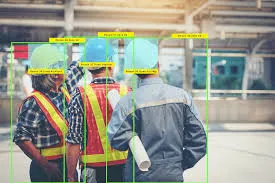In high-risk work environments—such as construction sites, manufacturing plants, oil refineries, and chemical processing facilities—the margin for error is extremely slim. Safety is not just a protocol; it is a non-negotiable requirement that protects lives and ensures seamless operational efficiency. One of the most critical aspects of workplace safety is the use of Personal Protective Equipment (PPE), which includes items such as helmets, safety goggles, gloves, face shields, reflective vests, and more. However, the mere availability of PPE is not enough. Ensuring that workers actually wear the correct PPE at all times has historically been a major challenge, especially in large-scale or fast-moving environments. This is where PPE detection technology becomes indispensable.
PPE detection uses advanced vision-based systems, often powered by artificial intelligence, to automatically monitor whether employees are complying with PPE regulations. This automated approach is quickly becoming a cornerstone of modern industrial safety, offering real-time insights, automated alerts, and verifiable data to support ongoing safety initiatives.
The Human Factor in Safety Compliance
Despite strict regulations and safety training programs, human behavior remains unpredictable. In busy environments where deadlines are tight and tasks are physically demanding, workers may inadvertently or deliberately neglect wearing proper PPE. Fatigue, distractions, or even a false sense of safety can contribute to lapses in judgment. Supervisors cannot be everywhere at once, and manual monitoring is not only labor-intensive but also prone to human error or bias.
This gap between safety policies and actual compliance on the ground has led to countless preventable injuries and fatalities. The traditional methods of enforcing PPE usage—such as random checks or supervisory oversight—are no longer sufficient in industries where a single moment of carelessness can lead to irreversible consequences. To bridge this gap, PPE detection technology offers a scalable and reliable solution.
What Is PPE Detection and How Does It Work?
PPE detection systems utilize advanced cameras and AI algorithms to automatically identify whether individuals in a specific area are wearing the required protective gear. These systems are trained to recognize various PPE types, such as hard hats, safety vests, gloves, goggles, and masks. The technology can function in real-time, scanning video feeds from CCTV or specially installed cameras across the facility or worksite.
Once the system detects non-compliance—say, a worker without a helmet in a designated zone—it can trigger immediate alerts to supervisors or security personnel. This allows for swift intervention, reducing the time between a violation and corrective action. Furthermore, the data collected through PPE detection systems can be logged and analyzed over time, enabling companies to identify recurring patterns, high-risk zones, or individuals with repeated infractions.
This data-driven approach helps shift safety enforcement from being reactive to proactive, allowing organizations to implement targeted training or redesign workflows for better compliance.
Elevating Safety Culture with Technology
One of the greatest advantages of PPE detection is its ability to reinforce a culture of safety across the organization. When workers know that there is an impartial, ever-watchful system ensuring compliance, the psychological impact is significant. It encourages consistent behavior and eliminates the tendency to cut corners. Unlike human supervisors, an automated system does not experience fatigue, distractions, or oversight. It functions 24/7 with high accuracy, making it an ideal addition to high-risk environments that operate around the clock.
Moreover, the presence of such technology communicates the seriousness with which an organization takes its safety policies. It builds trust among employees, who feel assured that their wellbeing is a priority, and it instills confidence among stakeholders and regulators, who can see that compliance is actively monitored and enforced.
Reducing Incident Rates and Financial Losses
Workplace accidents are not only tragic—they are expensive. Injuries can lead to medical costs, compensation claims, lost productivity, and even legal action. In many regions, regulatory authorities impose heavy fines on companies that fail to enforce PPE usage. Beyond the immediate financial implications, the reputational damage of being associated with safety violations can be long-lasting.
By integrating PPE detection into existing safety protocols, companies can significantly reduce the risk of such incidents. The system acts as a constant guardian, ensuring that safety guidelines are not merely theoretical but actually practiced. This translates into fewer accidents, lower insurance premiums, and minimized legal exposure. Over time, the investment in PPE detection technology more than pays for itself through the savings generated from reduced incident rates and operational disruptions.
Building a Safer Future
Ultimately, PPE detection is not just about technology—it is about creating safer work environments where human lives are valued and protected. In high-risk industries, where the consequences of non-compliance can be fatal, relying on manual oversight alone is no longer acceptable. PPE detection systems bring accuracy, consistency, and accountability to safety enforcement, making them an essential part of any modern safety strategy.
By leveraging intelligent systems that monitor PPE usage in real time, businesses can build a proactive safety culture, reduce operational risks, and foster a workplace environment where everyone goes home safe at the end of the day. In a world where safety standards are becoming increasingly stringent and workforce wellbeing is under the spotlight, PPE detection is not just a technological upgrade—it is a necessity.
If your organization operates in a high-risk environment, now is the time to embrace PPE detection as a key pillar of your safety framework.



